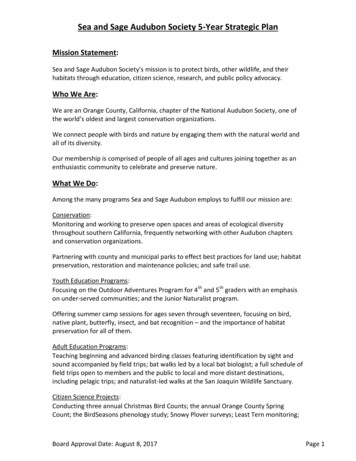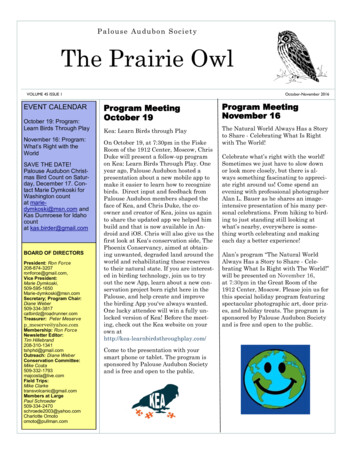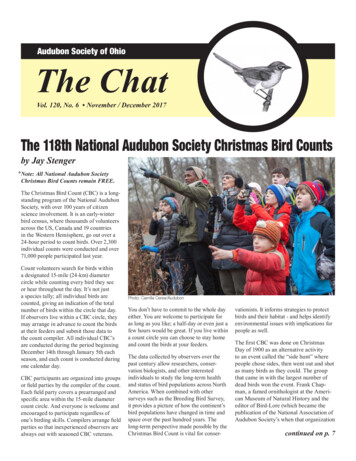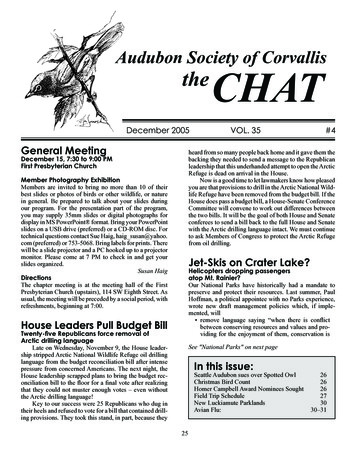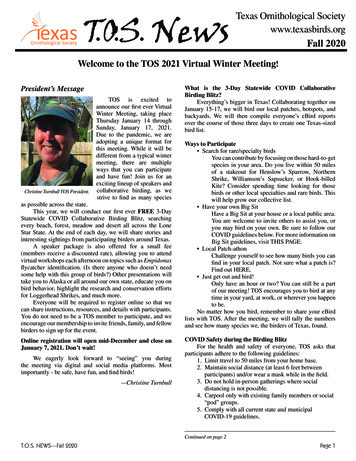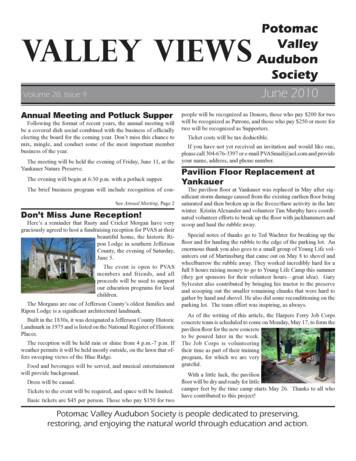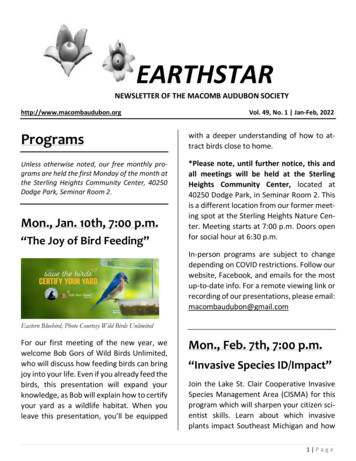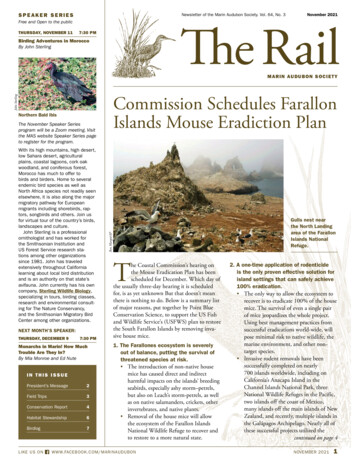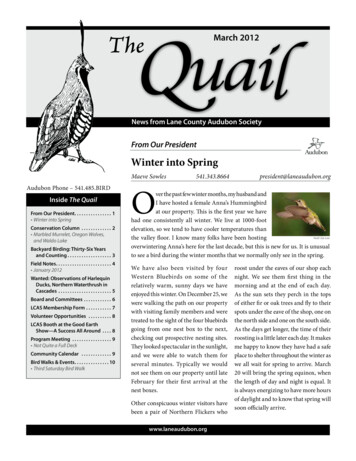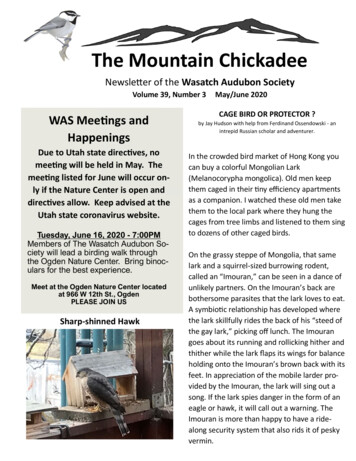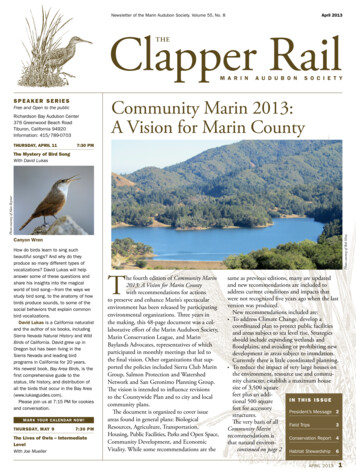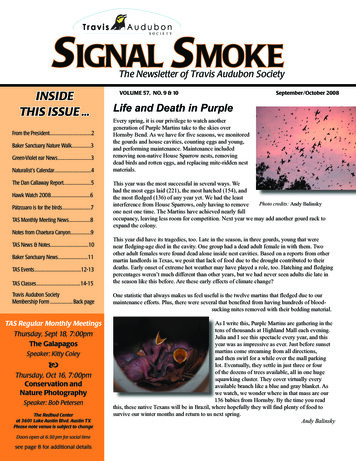
Transcription
S IGNAL S MOKEThe Newsletter of Travis Audubon SocietyINSIDETHIS ISSUE .From the President.2Baker Sanctuary Nature Walk.3Green-Violet ear News.3Naturalist’s Calendar.4The Dan Callaway Report.5Hawk Watch 2008.6Pátzcuaro is for the birds.7TAS Monthly Meeting News.8Notes from Chaetura Canyon.9TAS News & Notes.10Baker Sanctuary News.11TAS Events.12-13TAS Classes.14-15VOLUME 57, NO. 9 & 10September/October 2008Life and Death in PurpleEvery spring, it is our privilege to watch anothergeneration of Purple Martins take to the skies overHornsby Bend. As we have for five seasons, we monitoredthe gourds and house cavities, counting eggs and young,and performing maintenance. Maintenance includedremoving non-native House Sparrow nests, removingdead birds and rotten eggs, and replacing mite-ridden nestmaterials.This year was the most successful in several ways. Wehad the most eggs laid (221), the most hatched (154), andthe most fledged (136) of any year yet. We had the leastPhoto credits: Andy Balinskyinterference from House Sparrows, only having to removeone nest one time. The Martins have achieved nearly fulloccupancy, leaving less room for competition. Next year we may add another gourd rack toexpand the colony.This year did have its tragedies, too. Late in the season, in three gourds, young that werenear fledging-age died in the cavity. One group had a dead adult female in with them. Twoother adult females were found dead alone inside nest cavities. Based on a reports from othermartin landlords in Texas, we posit that lack of food due to the drought contributed to theirdeaths. Early onset of extreme hot weather may have played a role, too. Hatching and fledgingpercentages weren’t much different than other years, but we had never seen adults die late inthe season like this before. Are these early effects of climate change?Travis Audubon SocietyMembership Form .Back pageOne statistic that always makes us feel useful is the twelve martins that fledged due to ourmaintenance efforts. Plus, there were several that benefited from having hundreds of bloodsucking mites removed with their bedding material.TAS Regular Monthly MeetingsThursday, Sept 18, 7:00pmThe GalapagosAs I write this, Purple Martins are gathering in thetens of thousands at Highland Mall each evening.Julia and I see this spectacle every year, and thisyear was as impressive as ever. Just before sunsetmartins come streaming from all directions,and then swirl for a while over the mall parkinglot. Eventually, they settle in just three or fourof the dozens of trees available, all in one hugesquawking cluster. They cover virtually everyavailable branch like a blue and gray blanket. Aswe watch, we wonder where in that mass are our136 babies from Hornsby. By the time you readthis, these native Texans will be in Brazil, where hopefully they will find plenty of food tosurvive our winter months and return to us next spring.Andy BalinskySpeaker: Kitty Coley Thursday, Oct 16, 7:00pmConservation andNature PhotographySpeaker: Bob PetersenThe Redbud Centerat 3601 Lake Austin Blvd. Austin TXPlease note venue is subject to changeDoors open at 6:30 pm for social timesee page 8 for additional details
Travis Audubon SocietyGeneral Address3710 Cedar Street, Box 5Austin, TX. 78705Phone numbers listed below withoutan area code are local numbers in the512 area.OFFICERS AND DIRECTORS2008-09PresidentMarsha MayVice PresidentValarie BristolTreasurerRoger BeckmanSecretaryClaude in DoughtyBill EdwardsShelia HargisKelly LoganChris MaseyJeff MundyTerri SiegenthalerExecutive DirectorNancy ManningIFrom the TAS Presidentwrite this note to you during the dog days of summer. Today may turn out tobe one of the hottest days yet – forecast calls for the temperature to possiblyreach 105 degrees F. Makes me yearn for the cool days of autumn. Enoughof that – you would probably be much more interested in knowing aboutwhat is going on with your society. Well, your Travis Audubon Society (TAS)Board took off the month of July and a working retreat is planned for August.That doesn’t mean that we didn’t do any work, we just did it all through email, over the phone, and/or participating in a committee meeting or two. Ourexcellent Executive Director, Nancy Manning, and our hard working TAScommittees have been busy this summer, working on a plethora of plans forthe future of our organization. The office staff has been working hard to updatethe membership database and we still need a host of information from manymembers who didn’t fill out the TAS member’s survey. So, if you haven’t filledout the survey, please contact the TAS office at 300.BIRD and see how youcan get this done. This information is important to our organization for manyreasons.Some highlights for you to mark in your calendar for the near future arevolunteer opportunities such as helping out at the TAS booth at the TexasParks and Wildlife Department’s EXPO the weekend of October 4 and 5;continued on page 5300-BIRDAdministrative AssistantJocelyn Taijeron300-BIRDCOMMITTEE AND SUBCOMMITTEE CHAIRSTAS Rare Bird AlertBAKER SANCTUARY STEWARDJohn Wilcox219-8425AdvocacyBird RecordsCHAETURA CANYON SANCTAURYSTEWARDSHabitat ConservationEducationGeorgean & Paul Kyle266-3861ACT REPRESENTATIVESJohn Kelly (state president) 331-8693Bryan Hale (state treasurer) 474-5599SIGNAL SMOKE EDITORTess Sherman300-BIRDTAS TELEPHONEThe office number is 512-300-BIRD(2473). To leave a message for BoardPresident Marsha May, press 1. To reportsightings of rare or unusual birds in Central Texas, press 3. To ask a bird-relatedquestion, press 4.TAS WEB SITEwww.travisaudubon.orgTAS EMAILinfo@travisaudubon.orgSignal Smoke (ISSN 1931-9282)Signal Smoke is printedon recycled paperusing soy ink.2Mission StatementThe Travis Audubon Society promotes the enjoyment, understanding,and preservation of birds, other wildlife, and their habitats in Central Texas.S I G N A L S M O K E / September/October 2008Field TripsHornsby BendHospitalityLatin perty and FinancePublicationsSanctuary ChairSociety HistorianYouth EducationUrban HabitatEric CarpenterJeff MundyLawrence BufordEthel KutacValarie BristolByron StoneJean MartinLaurie FossPriscilla MurrSusan MoakBob WarnekeNancy ManningAnn GardnerKelly LoganTess ShermanTerri SiegenthalerJohn KellyJulia BalinskyJane Tillman300-2473select option T SIGNAL SMOKESubscription InformationSignal Smoke (ISSN 1931-9282), was published 11 times yearly through Volume 56,No.4, and beginning with Volume 56, No.5,is published 6 times yearly. Subscriptionis a TAS membership benefit. To join, usethe form on the back page of this issue orgo to www.travisaudubon.org for an onlineform. For address or subscription changes,please call 512.300.BIRD (2473) or e-mailinfo@travisaudubon.org. The USPS does notforward Signal Smoke. Copyright 8 2008. Nopart of this publication may be reproducedwithout permission in writing from TravisAudubon Society.Newsletter DeadlineThe submissions deadline is the first day of themonth preceding the first month of publication(for example, June 1 for the July/August issue).Submit uncopyrighted articles, announcements,and art to Tess Sherman, tsherman1@austin.rr.com; or mail to 210 E. Walnut Dr., Austin,TX 78753. Submissions by email or on a CDare preferred but not required. Call Tess at 300BIRD if you have questions.TRAVIS AUDUBON SOCIETY
Baker Sanctuary Nature WalkOn June 7th I co-led a nature walk at the Baker Sanctuarywith Marshall Johnston and Barry Lyon. Since Goldencheeked Warblers are most readily seen in March andApril I thought we would be lucky to find even one Goldencheek. We had not walked very far on the trail when Barryspotted our first Golden-cheek family. That was the first of fivefamilies we encountered, the most Golden-cheeks I have everseen in a morning. Happily all these families contained youngbirds that must have fledged in the last couple of weeks. It wasencouraging to see so many young birds even after a spring whenrainfall and thus insects were not plentiful. These birds were veryconfiding, affording us point blank looks.In addition to the Golden-cheeks we saw twenty-two otherspecies of birds including Blue-gray Gnatcatchers, a Black-andwhite Warbler, Ash-throated Flycatchers, and a Cooper’s Hawk. Astunningly beautiful Scissor-tailed Flycatcher that was perchednear the ground put on a great show, hovering over the grass tocatch insects and showing its intensely pink “armpits”.Thanks to Marshall Johnston, one of Texas’ premier botanists, weidentified 55 species of plants. Marshall told us interesting factsabout some of the plants. For example he mentioned that mullenwas brought to the New World by the Spaniards so they could usethe ground-up dried seeds as a fish poison!Following the walk we enjoyed a delicious brunch catered byHeidi Wittenborn of The Adequate Snack. From the brunch tablewe spotted our final family group of Golden-cheeks, a fittingending to a wonderful morning.From left to right: Victor Emanuel, Marshall Johnstonand Barry Lyon. Photo Credit: Terri SiegenthalerGreen Violet-ear visits TAS Member’s Best ofTexas Backyard Wildlife HabitatOn Tuesday, July 15, imagine my surprise when Isat down to lunch with a friend and saw a HUGEhummingbird perched at the feeder I had just put upthe day before. (I always wait until I see some Black-chinnedactivity at my Turk’s Cap, before putting it out.) My first thoughtwas “a Magnificent” (it had been a year since I had seen one outin Arizona), but a look in Sibley quickly ruled that out. The blueear patches, blue breast and the black bill were so distinctive,along with the black band in the tail, which it cooperativelyfanned.After struggling for a couple of hours to get pictures throughthe window, I had the brainstorm to call TAS member andphotographer extraordinaire Jim deVries and invited him tocome over to try to document it. Wouldn’t you know that onceJim got here about 4 p.m. it never showed again before we bothhad to leave to get to the TAS Hummingbird ID class. It wasgreat fun to walk into the class and announce that I had a GreenViolet-ear in my backyard - and to see instructor Mark Klym’sexpression. If you don’t know Mark, he is with Texas Parks andWildlife and is the Hummingbird Roundup coordinator amongother things.My husband, Mark, saw the hummer early the next morning(he carefully ruled out the Broad-billed) and Mark K. and Jimarrived about 9:30 a.m. They waited until 12:15 p.m. or so whenJim got fantastic photos. I was so thankful that my ID had beenTRAVIS AUDUBON SOCIETYI had returned a few days earlier from a month in Sicily,Sweden, and Scotland. This nature walk at Baker was the perfecthomecoming for me.Victor Emanuelcorrect! With Mark Klym’s advice and a little trepidation, Iposted the sighting to Texbirds, and hosted about thirty peopleover the next several days - only three of whom were luckyenough to see it: Jesse Huth, his mom, Jaci Krupa, and LynneSchaffer. I finally had one last look at it on Monday, July 21stwhen it was hawking insects over a live oak, rhythmicallyflying back and forth, in time with its characteristic voice.Mark Klym managed to get the Austin American-Statesmaninterested in an article and it ran in the Tuesday, July 22 newspaper. It was exciting to have such a wonderful hummingbirdcome to my Best of Texas Backyard Wildlife Habitat. Providethat habitat, and with a little luck, who knows what might benext - a Magnificent?Jane TillmanPhoto Credit: Jim deVriesS I G N A L S M O K E / September/October 20083
NATURALIST’SCALENDARby Bill Reinerphoto by Robert BaumgardnerArevised and reprinted from an earlier columnmong September’s loose flocks of ambiguous yellowishwarblers, brown flycatchers, and other small migrantbirds, you may spot a troupe of three or four BaltimoreOrioles drifting quietly through the treetops. The adult males arestill bedecked in striking black and orange, but most of the othersare costumed in the muted pale orange and brown of the females.The majority of these are immature birds, taking their first tourto the wintering areas that stretch from Mexico to northernVenezuela.Bobolink, as well as the orioles. What, you might wonder, dothe prairie-dwelling meadowlarks, the marsh-loving blackbirds,and the arboreal orioles have in common? They certainly looknothing alike.The plumages of immature Baltimore Orioles – especially thatof the females – are quite variable. Some closely approachthe yellowish breast, white belly, and olive back of the femaleand immature Bullock’s Orioles, which may also be migratingthrough Central Texas now. A handy field guide will be helpful tosort out the fine points of identification, but some birds may beimpossible to identify with certainty in the field.There are two different sets of muscles for opening and closinga bird’s bill. For most birds, the muscles that close the bill aremuch larger and stronger than those for opening it. Strong billclosing muscles ensure a firm grip on prey, or help to crackthe hard exoskeletons of some insects or the shells of seeds. Inorioles and other icterids, however, the muscles that open the billare larger and stronger than those of most other birds, sometimeseven larger than the muscles that close the bill. Of what possibleuse could that be?There are also many hybrid Baltimore X Bullock’s Orioles.The two species interbreed where their ranges intersect fromwestern Oklahoma north to Alberta. For this reason, in 1983 theAmerican Ornithologists’ Union (AOU) elected to lump the twospecies into one, called the Northern Oriole. However, geneticstudies since then suggest that the two species are distinct.Though they are closely related, they are actually not as close asthe widespread hybridization might suggest. In fact, BaltimoreOrioles may be more closely related to the Alta Mira Oriolesof the lower Rio Grande valley, and Bullock’s Orioles to theStreak-backed Orioles that sometimes wander into Arizona fromMexico. The AOU has since reversed their decision, and we nowhave Baltimore and Bullock’s Orioles again.If you keep your hummingbird feeder filled in September,you might be startled to see a big orange “hummingbird”investigating it. Orioles have a taste for nectar, and will alsopartake of the sugar-water that hummingbirds enjoy. A cut-openorange or banana placed in a feeder may also attract an oriole’sattention.Hummingbirds, with long bills and tongues specialized forreaching nectar in tubular flowers, have a distinct advantage overorioles. So an oriole often ignores the “front door” (so to speak),and instead punctures the base of the flower tube with its sharplypointed bill, to reach the sweet liquid there. From the perspectiveof the plant, this method is cheating, because the oriole bypassesthe pollen that is the whole point of the plant producing thenectar.Orioles are members of the Icteridae family, sometimes called theNew World Blackbirds (as opposed to the Blackbird of Europe,which is actually a thrush, and a close relative of the AmericanRobin). The icterids of North America are an eclectic bunch,including the meadowlarks, blackbirds, cowbirds, grackles, and4S I G N A L S M O K E / September/October 2008One common characteristic is that wedge-like bill. It can be shortand stout on a cowbird, long on a grackle, or curved as on someorioles, but it is always sharply-pointed and thick-based. Themusculature that operates it is also unusual.It’s very useful, in fact, for prying things open: widening the holepunctured at the base of a flower, for instance. Or pulling apartthe webbing in which some insects wrap themselves. Oriolessometimes use this technique – called “gaping” – to widen theholes they poke through the rinds of fruits; the prying actionsqueezes juice from the pulp, which the orioles then lap up withbrush-tipped tongues. They also use it to pry up flakes of bark ontree limbs to reach insects hidden beneath.The eyes of icterids are positioned lower on the head than onmany birds, in direct line with the lower edge of the uppermandible. Orioles can then look right down the gap betweenthe two mandibles to see what is hidden inside that rolled-upleaf, or between two leaves webbed together. A meadowlark canfind insects hidden in tightly-bunched grasses. A Red-wingedBlackbird can peer between the leaves of cattails.Gaping allows icterids access to food sources that other birdscan’t reach. That’s an important advantage for the relativelyheavy-bodied oriole trying to compete for food with light-weightchickadees, warblers and vireos while foraging along the thinbranches of the treetops.You may have trouble seeing an oriole gaping as it searches forfood high in a leafy tree canopy. Instead, try watching a Greattailed Grackle foraging on a lawn to witness this interesting foodfinding behavior.A source of information for this column was Blackbirds of theAmericas, by Gordon H. Orians.TRAVIS AUDUBON SOCIETY
THEDan Callaway,photo by Robert BaumgardnerDAN CALLAWAYREPORTBirding to Bastrop County - 7/16/08Participants: Ethel Kutac, Janene Rowan, Emil Levasseur, MikePurdy, Catfish Kelly, and Dan CallawayTarget bird: Bald Eagle (not seen)We spent from 8 to 10:30 a.m. along the Colorado Riverin the Tahitian Village sub-division. Newly maintainedhiking trails with several access points were quitehelpful. While watching a Pileated Woodpecker perched in adead tree, another flew directly overhead, giving his hauntingcall before joining his mate. Other good sightings in the areawere Great Blue, Little Blue, and Green Heron, Mississippi Kite,Greater Roadrunner, Yellow-billed Cuckoo, Chimney Swift,Ruby-throated Hummingbird, Red-bellied Woodpecker, EasternWood-Pewee, American Crow, Carolina Chickadee, TuftedTitmouse, Carolina and Bewick’s Wren, Blue-gray Gnatcatcher,Eastern Bluebird, White-eyed and Red-eyed Vireo, NorthernParula, Summer Tanager, Northern Cardinal, Painted Bunting,Common Grackle, and first-year male Orchard Oriole.President’s Note, continued from page 2and also helping the youth of Travis County learn how to usebinoculars and find those birds in the trees at the TAS’s YouthBirding Camp on October 18. For a fun time, put December7 on your calendar for the TAS Holiday Gala – who knows– maybe the Texas Parks and Wildlife Band will be backfor more rocking and rolling. We also have big plans for thespring of 2009. Travis Audubon Society is hosting the TexasOrnithological Society’s Spring Meeting on April 23 toApril 25 in conjunction with the Balcones Songbird Festival.It should be a fantastic birding event! Save that weekend andkeep your eyes open on our web site for more information.Marsha MayThis year’s Expo will beheld at Texas Parks &Wildlife headquartersin Austin on October 4th &5th, 2008. Begun in 1992 as atribute to hunting, fishing andthe Great Outdoors, Texas Parks& Wildlife Expo celebratesits seventeenth anniversarySaturday and Sunday, October 4 & 5, 2008. Texas Parks andWildlife headquarters in Austin will be transformed into the siteof the largest event of its kind in the nation. Last year over 42,000visitors enjoyed Expo!Our next area was Colo-Vista and Ponderosa Road. Here weadded Crested Caracara, Red-shouldered and Broad-wingedHawk, Black Vulture, Killdeer, Downy Woodpecker, PurpleMartin, and House Finch. Continuing Southeast on Hwy 71,we exited to Buescher State Park, seeing Cliff Swallows andHouse Sparrows under the overpass. In the park we never heardthe expected Pine Warblers singing. However, we did findone frantically trying to keep an ungrateful, hungry cowbirdfed. Other notable birds: Cattle Egret, Red-tailed Hawk,Eurasian Collared-Dove, Common Nighthawk, Scissor-tailedFlycatcher, Western Kingbird, Northern Mockingbird, Caveand Barn Swallow. Expected birds not seen were Great-crestedFlycatcher, Eastern Phoebe, and Indigo Bunting.Total species: Fifty-fiveBest bird: Pileated WoodpeckerDominant species: Purple MartinIn MemoriamOn a sad note, Travis Audubon Society lost a very importantmember recently. Gray Jolink, a member of the TAS Board,passed away suddenly on June 23, 2008. He will be trulymissed. Travis Audubon Society is planning to build a ChimneySwift tower in his memory in a location chosen by Gray’sfamily. Chimney Swift authorities and TAS members, Georgeanand Paul Kyle, along with Board Member Chris Masey, havevolunteered to donate their labor in the construction of thetower in memory of Gray. Donations from TAS members willbe greatly appreciated.Marsha Maybike, see and touch wildlife,learn about recreation in theGreat Outdoors and see andbuy the latest in outdoorgear and services. Mostimportantly, visitors can learnhow they can help to conservethis precious resource. And it’sFREE!Presented by Texas Parks and Wildlife and a coalition ofconservation organizations, agencies and sponsors, Expocelebrates the diversity of the outdoor experience in Texas. Fromcamping and outdoor skills to shooting sports and fishing, fromWhat is the Texas Parks and Wildlife Expo? It’s an outdoorbird watching to paddle sports, Expo visitors have an opportunityexperience where visitors fish, shoot, kayak, rock climb, mountain to try their hands at two full days of fun in the outdoors.TRAVIS AUDUBON SOCIETYS I G N A L S M O K E / September/October 20085
Hawk Watch at Hornsby BendIt’s time for the Hawk Watch at Hornsby Bend! Fall migrationis beginning, and that means it’s time once again for hawkwatching at Hornsby Bend. Predators are important indicatorsof ecosystem health and it is important to monitor the status ofpopulations. By counting migrants, the numbers of these birdscan be tracked from year to year, and migration routes can bedetermined. The Hornsby Bend Hawk Watch, a joint project ofTAS and the Hornsby Bend Bird Observatory, is part of the effortto learn about hawk migration.Common raptors sighted at Hornsby Bend are Mississippi Kites,most abundant in late August to early September, and Swainson’sHawks, which come through in mid to late October. Both speciescan be seen in large groups called “kettles”, although often thebirds are quite high and difficult to see. Other species that areregularly observed include Red-tailed and Red-shouldered Hawks,Broad-winged Hawks, Sharp-shinned and Cooper’s Hawks,and Black and Turkey Vultures. Less common species includePeregrine Falcons and Merlins, but occasionally something reallyspecial comes through, like the Swallow-tailed Kites that GaryNewgord listed last year!We also count other migrant species, such as Anhingas, WhitePelicans, Long-billed Curlews, and Wood Storks. The ponds attractmany ducks and shorebirds, as well as other interesting migrantssuch as butterflies and dragonflies. The Monarch Butterflymigration occurs in mid-October, and some days the skies arefilled with butterflies. Dragonflies are an important food source formany birds, especially Mississippi Kites and Swainson’s Hawks;sometimes these hawks come quite close while feeding.Our DonorsWe thank these persons and groups who generously made recentcontributions to Travis Audubon Society (as of press time):Baker SanctuaryRichard CarlsonHornsby BendTerry BanksGeneralVirginia BleckJames BrushNorma L. HutchinsonSuraiya MurrayPatricia SharpePainted Bunting MembershipVanessa ChiapettaDertien FamilyJoe HaggardSuzanne McAnnaMark McClellandElsie MogckDiana M. SeidelAndrew J. SenchackColleen TheriotDebbye WallaceVireo MembershipMary Elizabeth BoothDavid Fischer6Shelia Hargis & Laurie FossElizabeth J. MaximCharles MichalikSteven PickrelBill Reiner, Jr.Becke RunteKim SoechtingWarbler MembershipValarie BristolLifetime MembershipSam BurnesIn Memory of Robert P. SanchezShelia HargisIn Memory of Raymond CarltonJon Donaldson & Mary RocamoraIn Memory of Gray JolinkBarbara AndersonNancy CravenGeorge DillinghamAnne & John DonovanShelia HargisLily KnopmanKelly LoganOliver RadkeyS I G N A L S M O K E / September/October 2008Since 2000, we’ve seen the numbers of raptors at Hornsby Bendvary considerably, from over 17,000 in 2004 to just over 5,000in 2007. Why the numbers are so variable, we don’t yet know.Drought, hurricanes, and conditions in the northern plains mayinfluence the population levels and movements of the birds fromyear to year. We don’t know what guides the hawks, whether itis weather patterns, or landmarks, so it is difficult to say what wecan expect this year.This year’s count period begins around August 20, and will gothrough October 22. I’ll be at the site from 9 a.m. until 4:30 p.m.,or later if necessary, and depending on the weather.Volunteers are needed for two days per week, to be determined.I plan on being at the watch for four to five days a week duringmost of the season, and more during the expected peak times;however, the hawks don’t work on a schedule. Therefore, itwould be great to have people who could come out once or twiceduring the hawk watch period to fill in on days I am not there.I will teach volunteers the proper counting protocols, and howto ID distant hawks, and you would have the opportunity to bepart of this important scientific effort. If you are interested involunteering, please call the TAS office at 300-BIRD.I am still planning my schedule as of press time, but I willannounce my days and times ASAP. Come out and join me, or bethe official counter for the day!Peg WallaceImre KarafiathBrad LiretteRobert ManningLorraine MarkoffSteven MatherlyWhooping Cranes/Welder Flats Jennifer MaxwellRalph C. AldersonCarol McCaslandKeith ArnoldMark & Teri McClellandShawn T. AshbaughWilliam MoonColin BludauBernadette NollPaul BrickDiane NunleyDavid BryantRichard PayneMartha BurkeSonia RallsSue CarterLora RenderDebra CorporaRoxie & Kim RochatFrance P. DavisWilliam RountreeMatt DozierDebra ScheuermanHoward Dodge Engelman, M.D.David & Susan ScottTed EubanksGael & Leslie SimonsMary & Billy FergusonPamela SmolenBobbye FrazierAmy SummerfeltBrush FreemanGeneva SwingCharmaine GansonTobi TroxellShelia Hargis & Laurie FossLarry VaughnKenneth HartmanCarol WellsJoe HearnBert WesslingJose HernandezDan @ Wordsmith of AustinPatsy IngletRobert YorkCarolyn JohnsonSusan YostAnthony JonesSusan ZimmermanEmy Lou SawyerSkip ShumpesValerie StaatsValerie WengerTRAVIS AUDUBON SOCIETY
Pátzcuaro is for the birdsBirders are always seeking good venues and there are anumber of reasons to visit a little-known pueblo in theColonial Circle of Mexico. For the cross-border birder,Pátzcuaro, Michoacán bundles a great package—a temperatemountain climate, good birding, and rich culture.The geographical characteristics of this region, located in the eastwest Central Volcanic Belt of Mexico, are noteworthy. Pátzcuarolies at 7200 feet of elevation; pine-oak forests, streams, waterfallsand lakes abound. Precipitation averages forty-one inches peryear, most of which falls from June to September, bringing coolsummer days, lush vegetation and bright flowers. Birding here is asensory pleasure.These attributes were enough to bring us Seattle Audubon MasterBirder Georgia Conti, who recently moved to Pátzcuaro, bag andbaggage. Georgia founded the Pátzcuaro Birding Club, whichhas greatly increased local birding activity. Our group objectivesinclude birding, building a current checklist for this area, andrecording the sites where specific birds can best be found. Weshare this information with visitors and residents for their birdingpleasure.Diverse habitats in this zone support a variety of birdlife whichincludes such exotic and endemic species as: Long-tailed WoodPartridge, Mountain Trogon, Russet-crowned Motmot, Goldencheeked Woodpecker (I watched a nesting pair at length), Whitestriped Woodcreeper, Pine Flycatcher, Gray-barred Wren, SpottedWren, Happy Wren, Black-polled Yellowthroat, Red Warbler,Red-breasted Chat, Rufous-capped Brushfinch, Cinnamon-belliedFlowerpiercer, and one of my backyard favorites, Black-backed(Abeille’s) Oriole. Just these birds will surely tempt you.A few weeks ago, a small group from the Pátzcuaro BirdingClub met to observe hummingbirds at two backyard feeders.Some twenty-five birds at a time hovered and fed. The busy mixincluded seven species: Green Violet-ear, Broad-billed, Whiteeared, Berylline, Blue-throated, Magnificent and Violet-crownedhummingbirds. Seeing the Violet-crowned hummingbird was areal treat--not an everyday occurrence, even here. I particularlyenjoyed seeing the different species side by side,which helps imprint size, field marks, and giz on my brain. All inall, a good birding event.To interesting avifauna and enjoyable natural setting, add thearea’s bonus attractions. Just two hours away, in the Spring, walkthrough magnificentorange clouds ofMonarch butterfliesas they begin theirmigration north.In Pátzcuaro, strollthrough cobblestonestreets to enjoycolonial buildings.Purhépecha Indianculture colors the townand skilled artisansMagnificent Hummingbird.craft an abundance ofPhoto credit: Wayne Colonyfolk art in many materials. Thedaily market displays adazzling array of freshvegetables and fruits.No wonder my husbandand I were lured here.For almost five yearswe have gone back andforth between a housein Austin and a housein Pátzcuaro. PátzcuaroWhite-eared Hummingbird.offersgoodbirds, a climate thatPhoto credit: Wayne Colonywell complements Austin’s, andrich colonial and Indian culture. Come bird with the PátzcuaroBirding Club. You can even find a birdingpal in Pátzcuaro.tracynovinger [at] gmail (d0t) comwww.birdpatzcuaro.blogspot.com/ (has
The Travis Audubon Society promotes the enjoyment, understanding, and preservation of birds, other wildlife, and their habitats in Central Texas. From the TAS President TAS Rare Bird Alert Eric Carpenter 300-2473 select option #3 Advocacy Jeff Mundy 334-4300 Bird
